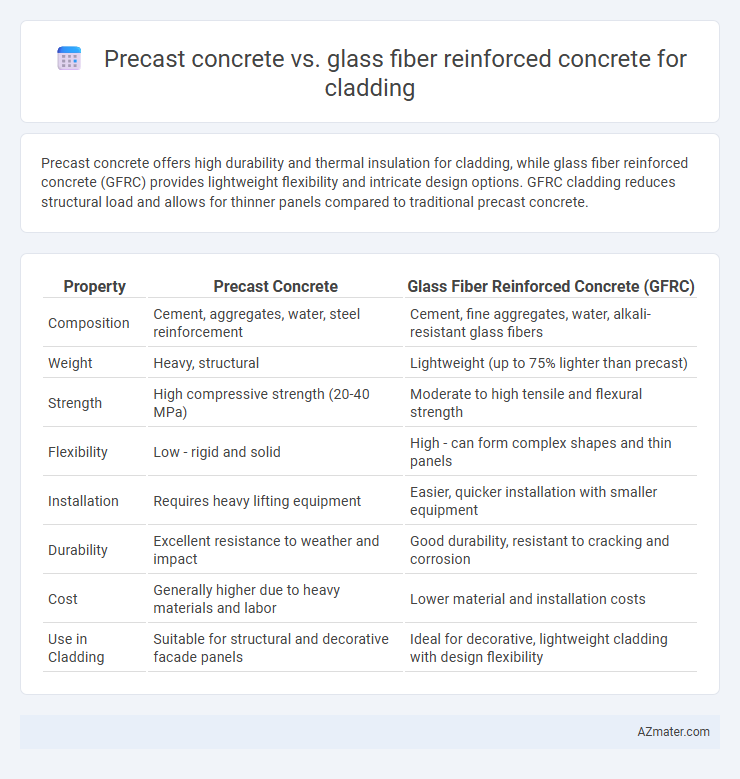Precast concrete offers high durability and thermal insulation for cladding, while glass fiber reinforced concrete (GFRC) provides lightweight flexibility and intricate design options. GFRC cladding reduces structural load and allows for thinner panels compared to traditional precast concrete.
Table of Comparison
| Property | Precast Concrete | Glass Fiber Reinforced Concrete (GFRC) |
|---|---|---|
| Composition | Cement, aggregates, water, steel reinforcement | Cement, fine aggregates, water, alkali-resistant glass fibers |
| Weight | Heavy, structural | Lightweight (up to 75% lighter than precast) |
| Strength | High compressive strength (20-40 MPa) | Moderate to high tensile and flexural strength |
| Flexibility | Low - rigid and solid | High - can form complex shapes and thin panels |
| Installation | Requires heavy lifting equipment | Easier, quicker installation with smaller equipment |
| Durability | Excellent resistance to weather and impact | Good durability, resistant to cracking and corrosion |
| Cost | Generally higher due to heavy materials and labor | Lower material and installation costs |
| Use in Cladding | Suitable for structural and decorative facade panels | Ideal for decorative, lightweight cladding with design flexibility |
Introduction to Cladding Materials
Precast concrete and glass fiber reinforced concrete (GFRC) are prominent cladding materials offering distinct advantages in architectural design and construction. Precast concrete provides high durability, load-bearing capacity, and excellent thermal insulation, making it ideal for large-scale structural panels. GFRC, characterized by its lightweight nature and high tensile strength due to embedded glass fibers, allows for intricate designs and faster installation while maintaining resistance to weathering and impact.
Overview of Precast Concrete Cladding
Precast concrete cladding offers exceptional durability, fire resistance, and thermal performance, making it a preferred choice for building exteriors. Manufactured under controlled factory conditions, it ensures high-quality finishes and precise dimensions, facilitating faster on-site installation. Compared to glass fiber reinforced concrete (GFRC), precast concrete provides greater structural strength and mass, enhancing sound insulation and load-bearing capacity.
Understanding Glass Fiber Reinforced Concrete (GFRC)
Glass Fiber Reinforced Concrete (GFRC) is a composite material composed of a cement-based matrix reinforced with alkali-resistant glass fibers, providing high tensile strength and lightweight properties ideal for cladding applications. Compared to traditional precast concrete, GFRC offers enhanced durability, reduced weight, and greater design flexibility, allowing for intricate architectural shapes and thinner panels without sacrificing structural integrity. Its resistance to cracking and weathering makes GFRC a preferred solution for modern facade systems requiring both aesthetic appeal and long-term performance.
Material Composition and Properties Comparison
Precast concrete cladding consists primarily of cement, aggregates, and water, offering high compressive strength, durability, and excellent fire resistance, while glass fiber reinforced concrete (GFRC) incorporates alkali-resistant glass fibers within a cementitious matrix, enhancing tensile strength, flexibility, and impact resistance. GFRC's lightweight nature allows for thinner and larger panels, reducing structural load and enabling intricate architectural detailing compared to the heavier, bulkier precast concrete panels. Both materials provide versatile weather resistance, but GFRC's improved crack resistance and lower permeability make it ideal for complex facade designs requiring enhanced performance and aesthetic flexibility.
Structural Performance and Durability
Precast concrete offers superior structural performance with high compressive strength and consistent quality due to factory-controlled production, making it ideal for heavy load-bearing cladding applications. Glass fiber reinforced concrete (GFRC) provides enhanced durability with excellent resistance to cracking, impact, and weathering, thanks to its fiber reinforcement which improves tensile strength and flexibility. Both materials contribute to long-lasting facade solutions, but precast concrete excels in structural integrity while GFRC is favored for lightweight, intricate designs with superior durability under harsh environmental conditions.
Weight and Installation Efficiency
Precast concrete typically weighs between 150 to 250 pounds per square foot, making it significantly heavier than glass fiber reinforced concrete (GFRC), which averages around 50 to 70 pounds per square foot. The lighter weight of GFRC panels enhances installation efficiency by reducing the need for heavy lifting equipment and allowing faster handling and placement on-site. This weight advantage of GFRC translates into lower transportation costs and quicker project timelines compared to traditional precast concrete cladding.
Design Flexibility and Aesthetic Options
Precast concrete offers high durability and a wide range of design options, including intricate textures, patterns, and finishes, making it ideal for large-scale cladding projects requiring uniformity and structural strength. Glass fiber reinforced concrete (GFRC) provides superior design flexibility with its lightweight composition, allowing for thinner panels and complex shapes that enable innovative, sculptural, and detailed facades. GFRC's extensive aesthetic options include diverse colors, textures, and translucency effects, making it suitable for projects prioritizing intricate design and visual customization.
Cost Analysis and Lifecycle Considerations
Precast concrete generally offers lower initial costs due to standardized manufacturing and economies of scale, while glass fiber reinforced concrete (GFRC) entails higher material and fabrication expenses but provides a lighter option with reduced structural support requirements. Lifecycle considerations favor GFRC for its superior durability, resistance to corrosion, and minimal maintenance needs, potentially offsetting upfront investment with long-term savings. Precast concrete's robustness suits high-impact environments but may incur increased maintenance costs over time due to potential cracking and weathering effects.
Sustainability and Environmental Impact
Precast concrete offers durability and thermal efficiency with lower embodied energy compared to traditional cast-in-place methods, enhancing sustainability in cladding applications. Glass fiber reinforced concrete (GFRC) provides a lightweight alternative that reduces transportation emissions and material waste due to its thinner profiles and high tensile strength. Both materials contribute to eco-friendly building practices, but GFRC's reduced carbon footprint during production and installation offers a distinct advantage in minimizing environmental impact.
Choosing the Right Cladding: Key Factors to Consider
Precast concrete offers superior durability and load-bearing capacity, making it ideal for large-scale cladding applications requiring high structural strength. Glass fiber reinforced concrete (GFRC) provides enhanced flexibility, lightweight properties, and intricate design possibilities for complex architectural facades. Key factors to consider include project scale, weight constraints, design complexity, weather resistance, and budget to determine the optimal cladding material.

Infographic: Precast concrete vs Glass fiber reinforced concrete for Cladding
 azmater.com
azmater.com